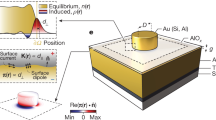
Overview
- Utilizes a two-tiered style of exposition: intuitive explanation of key principles in the first tier and further technical details in the second
- Bridges the gap between physics and engineering and computer science
- Presents the fundamentals of computational methods, electromagnetic theory, colloidal systems and photonic structures together with applications
- Covers "hot topics" in photonics, plasmonics, and metamaterials
- Includes full-color illustrations to enhance understanding
Part of the book series: Nanostructure Science and Technology (NST)
Access this book
Tax calculation will be finalised at checkout
Other ways to access
About this book
This second edition of a well-received book presents new perspectives on modern nanoscale problems, where fundamental science meets technology and computer modeling. Along with traditional computational techniques such as finite-difference schemes, finite element analysis and Ewald summation, the book describes a new finite-difference calculus of Flexible Local Approximation MEthods (FLAME), which qualitatively improves the numerical accuracy in a variety of problems. Application areas in the book include long-range particle interactions in homogeneous and heterogeneous media, electrostatics of colloidal systems, wave propagation in photonic crystals, photonic band structure, plasmonic field enhancement, metamaterials, backward waves and negative refraction, cloaking, focusing beyond the diffraction limit, and transformation optics. The second edition incorporates new chapters on metamaterials and on the finite difference time domain method (FDTD), an exposition of absorbing boundary conditions, and Miscellany – a collection of paradoxical or controversial subjects related to the main topics of this book. A vast volume of material has been updated, revised or rewritten.
Computational Methods for Nanoscale Applications, Second Edition, is accessible to specialists and graduate students in diverse areas of nanoscale science and technology, including physics, engineering, chemistry, and applied mathematics. In addition, several advanced topics will be of interest to the expert reader.
Similar content being viewed by others
Keywords
Table of contents (11 chapters)
-
Front Matter
-
Back Matter
Reviews
Authors and Affiliations
About the author
Before coming to the University of Akron, Tsukerman worked at the Department of Electrical & Computer Engineering, the University of Toronto (1990-1995). A joint project with GE Canada involved electromagnetic field analysis and noise reduction in large electric motors.
Tsukerman's academic degrees are from St. Petersburg Polytechnic in Russia: a combined B.Sc. / M.Sc. degree (with honors) in Control Systems (1982) and a Ph.D. in Electrical Engineering (1988).
Bibliographic Information
Book Title: Computational Methods for Nanoscale Applications
Book Subtitle: Particles, Plasmons and Waves
Authors: Igor Tsukerman
Series Title: Nanostructure Science and Technology
DOI: https://doi.org/10.1007/978-3-030-43893-7
Publisher: Springer Cham
eBook Packages: Physics and Astronomy, Physics and Astronomy (R0)
Copyright Information: Springer Nature Switzerland AG 2020
Hardcover ISBN: 978-3-030-43892-0Published: 22 August 2020
Softcover ISBN: 978-3-030-43895-1Published: 22 August 2021
eBook ISBN: 978-3-030-43893-7Published: 21 August 2020
Series ISSN: 1571-5744
Series E-ISSN: 2197-7976
Edition Number: 2
Number of Pages: XXVII, 707
Number of Illustrations: 77 b/w illustrations, 139 illustrations in colour
Topics: Nanoscale Science and Technology, Nanotechnology and Microengineering, Simulation and Modeling, Nanotechnology, Theoretical, Mathematical and Computational Physics, Optics, Lasers, Photonics, Optical Devices



